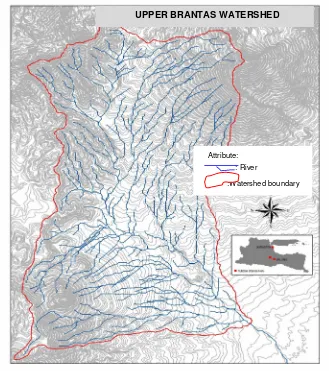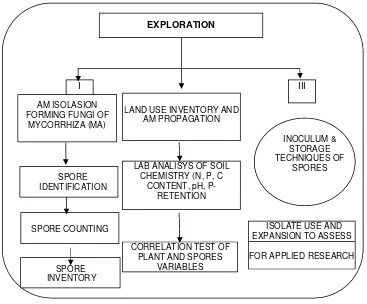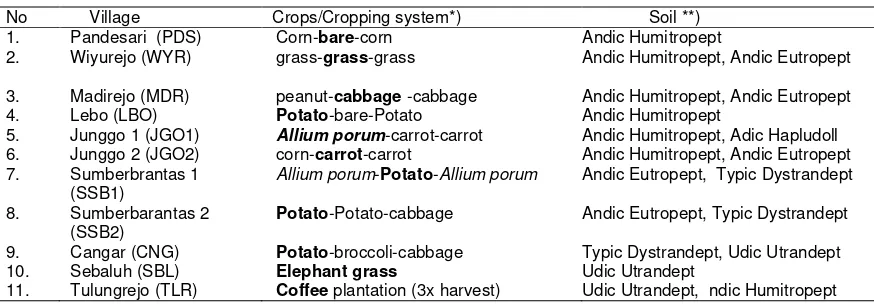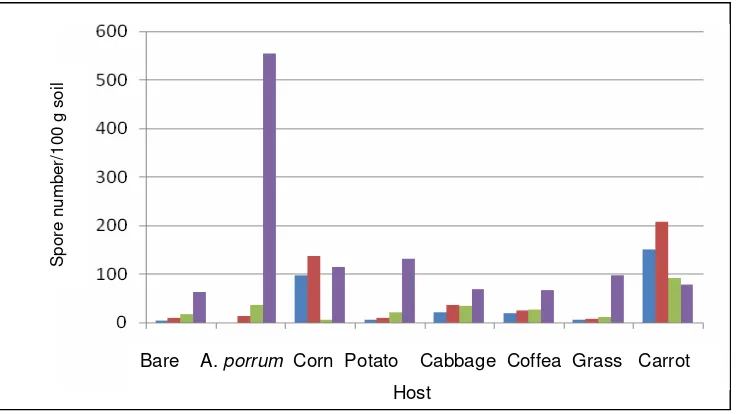ASSESSMENT OF THE EFFECT OF LONG TERM TILLAGE ON THE ARBUSCULAR
MYCORRHIZA COLONIZATION OF VEGETABLE CROPS GROWN IN ANDISOLS
Budi Prasetya1*) and Christopher Anderson2)
1*)Soil Science Department Faculty of Agriculture University of Brawijaya Jl. Veteran Malang 65145 East Java Indonesia
2)Soil and Earth Sciences Group, Institute of Natural Resources Palmerston North
Private Bag 11 222 Palmerston North 4442 New Zealand E-mail : [email protected] *)
Corresponding author phone :+62-341-551665 E-mail : [email protected]
Received : July 19, 2010/Accepted : October 23, 2010
ABSTRCT
In Indonesia, amount of biodiversity could be found including soil microorganism which were useful for sustainable agriculture. Everything lives in agricultural land were interacts and influences each others. Many factors of biotic and a-biotic environment such as land and climate fluctuation influences microbial expansion within the soils. For example arbuscular mycorrhiza (AM) which was formed by myches (fungus) and root of higher plant difference host plant. The implication of different host plant often close related to the soil management and properties. Soil sample that was collected from various host plant in the fields or bare land have been found varied spores. Andisols and its properties conserve higher organic matter relatively and developed in the cold temperature, therefore very suitable for AM expansion and also as natural resources stock of AM potentially.
Keywords: arbuscular mycorrhiza, andisols, soil tillage, AM colonization
INTRODUCTION
In Indonesia, organic and inorganic materials input are increasingly used to maintain high rates of productivity from agricultural land. Inputs used today include agro-chemicals such as fertilizer and pesticides. High rates of agro-chemical application are common to Andisols
present throughout the upland areas of Indonesia that support intensive vegetable crop production. This is especially true for the Malang district in East Java province which has been a centre of horticulture crop production for the past 20 years. As recently as 1984 this area was mostly covered by tropical forest (Anonymous, 1984). However, today the landscape is domi-nated by vegetable crops.
Intensive soil tillage has accompanied horticulture cropping by most farmers in this area. Vegetables are commonly grown for three months with the soil intensively tilled between cycles. Organic and inorganic fertilisers are routinely applied to growing crops. Slow release phosphate fertilizers such as super phosphate when applied over successive years can lead to long-term accumulation of insoluble phosphate in the soil (Munir, 1996). Both biotic (species diversity and abundance of microorganisms) and abiotic parameters of a soil can be affected by agrochemical residues present in the environment.
In Andisols, phosphate adsorption and desorption occurs according to a specific mechanism. Phosphate in the form of the phosphate species dihydrogen phosphate is readily fixed through specific adsorption to allophane minerals that are abundant in the weathering products of volcanic ash. Specifically adsorbed phosphate can not be absorbed by root plant, and therefore to increase the concentration of available P in the soil a high dosage of P fertilizer is necessary. Low available phosphate fertility is regarded as a major constraint for plant growth and production.
without consideration of the fertility status of soil (Bisht et al., 2009). But in the case of nutrients up everytake, especially P uptake, plant species with fine roots (as in grasses) are generally considered to be effective in soil phosphate uptake (Marschner and Dell, 1994). These fine roots are usually characterised as have an arbuscular mycorrhiza (AM) association.
Arbuscular mycorrhiza symbioses are formed by approximately 80% of vascular plant species in all of the major terrestrial biomes. Consequently, an understanding of their function is critical in any study of sustainable agricultural or natural ecosystems. The implications of recent results and ideas on AM symbioses are likely to be of particular significance for plants dealing with abiotic stresses such as nutrient deficiency and water stress (Smith et al., 2010). AM fungi may influence soil structure, carbon deposition in soil, and interactions with the soil microbial and animal populations, as well as plant-plant competition. These interlinked outcomes of AM symbioses go well beyond the effects of increasing nutrient uptake that are commonly discussed, and must be taken into consideration in work designed to understand the complex and multifaceted responses of plants to abiotic and biotic stresses in agricultural and natural environments. Biotic interactions can affect the distribution of species across environmental gradients. As air and soil temperatures increase, plant community response may depend on interactions with symbionts (Bunn et al., 2009).
Arbuscular Mycorrhiza (AM) associations have been noted for a range of host plants in the tropics (Bisht et al., 2009; Feddermann et al., 2010). Extent of colonization and the arbuscular mycorrhizal fungi (AMF) spore numbers for the dominant native plant species, pines; fruit tree, herbaceous crops, and shrub were studied by Becerra et al. (2009). The AM colonization, intraradical fungi structures and AMF spore numbers varied in species depending on phenological, climatic and edaphic conditions.
The aim of the research were to study the extent of AM distribution on the roots of a range of host plant cultivated in Andisols.,to study the effect of land-use on AM development for these host plants, and to identify AM forming fungi in the research area.
MATERIALS AND METHODS
This research was conducted over six months and comprised three stages (Figure. 1): (1) AM isolatation, propagation and identification (Chruz, 1991), from soil collected from the catchment area of the upper Brantas, East Java, Indonesia (2) Inventory of land use and AM in the catchment area of upper Brantas (3) assessment of AM in the laboratory of Soil Biology, Soil Science Department, Agriculture Faculty, Brawijaya University
Data collection
This research consisted of both field exploration and laboratory assessment. Field exploration was conducted in a part of the Brantas Watershed area, Malang District, East Java, Indonesia (Figure 1) Land uses in this area were grouped based on the actual crops on farm and interview to fixed the cropping system. Three replicate soil samples were collected from 0 – 30 cm depth in the root’s zone of the host plant to assessed soil pH (glass electrode, water, KCl and NaF solution), soil organic matter content (wet destruction and titration method), total and available soil P (25 N HCl and Bray 1, also to assessment of AM groups and spores number by wet seaving and quadrant counting (Chruz, 1991).
Study of Andisols Use and Properties
Preparation and survey of Andisol distribution was conducted in the first step of three steps (Figure 2) including:
1. Literature review of Andisols properties (Anonymous, 1984), with specific focus on Andisols of upper Brantas catchment area, Sumber Brantas village, and Cangar village, Malang District, East Java, Indonesia.
2. Exploration about Andisols use; including of actual crops and cropping system in this area involved 20 farmers.
Figure 1. Research Location in Upper Brantas Watershed
Field survey undertake: soil samples collected from land use groupings. Samples returned to lab for analysis AM and prepared to count spore number and collonization. The root samples were staining according to the methods described by Brundrett et al. (1984), and
percentage of colonized roots was evaluated by the “grid-intersect” method of Givanetty and Mosse (1980). Mycorrizal spore analysis was done by the method of Daniel and Skiper (1982).
UPPER BRANTAS WATERSHED
Attribute: : River
Figure 2. Scematic Steps of Spores Exploration and Inventory
RESULTS AND DISCUSSION
Andisol Distribution and Cropping System in the Research Area
Literature was surveyed with respect to the recorded presence of Andisols in the survey area. Many records were describing Andisols in terms of the old classification as order of inceptisols.
Andisols in this region are formed from volcanic materials typically found at an elevation mare than 700 m (asl), in a climatic environment with a pronounced wet season (humid) and high annual rainfall with no periods of drought (Siefferman, 1992). In Indonesia, Andisols have been found in the various areas with a range of elevation from 0 (beach) upto 3, 500 m above sea level (Munir, 1996). This total area of Andisols distribution is approximately 3, 126,000 ha of which 894, 000 ha is in Java island, 1, 875,000 ha in Sumatra, 169,000 ha in Bali
94,000 ha in Nusa Tenggara and 94,000 ha in Maluku. Andisol distribution in research area include Kalikonto catchment area is concentrated around Arjuno slope and Kawi Mountain (North and South of Research area respectively).
Soil order (old classification) and associated cropping system for a range of catchment villages are presented in Table 1. Long-term tillage appears to have affected the physical properties of these soils. In some areas the top soil (dark colour) appears thin and is extensively mixed with materials from the sub soil (bright colour). Soil samples collected and analysed for P adsorption from the 11 areas show values more than 85% averagely 95% (Table 3).
Various agricultural land uses were apparent in the catchment. although the dominant use was vegetable production. There has been land use change in the catchment II
SPORE ISOLATE ASSESSMENT
I III
AM ISOLASION FORMING FUNGI OF
MYCORRHIZA (MA)
LAND USE INVENTORY AND AM PROPAGATION
LAB ANALISYS OF SOIL CHEMISTRY (N, P, C
CONTENT, pH, P-RETENTION
SPORE INVENTORY
CORRELATION TEST OF PLANT AND SPORES
VARIABLES
ISOLATE USE AND EXPANSION TO ASSESS
FOR APPLIED RESEARCH INOCULUM &
STORAGE TECHNIQUES OF
SPORES EXPLORATION
SPORE IDENTIFICATION
area compared to the Land Use Map (1984), with some areas recorded as forestry now under food crops production. This indicates that soil tillage is becoming more intensive with time.
The dominant cropping system is based on the use of perennial crops were land preparation and intense soil tillage is necessary. This mixes the top and sub soil within the disk plow layer leading to the destruction of soil aggregates.
Soil repositioning from the top soil to be sub soil and from the sub soil to the top soil is constantly occurring as a result of soil tillage. This process of physical soil rearrangement and alternating crop use can influence spore numbers of mycorrhiza forming fungi.
Various crops were grown in the different soil tillage and the different species AM were expanding with unstable spore number in the field. Species of AM and spore numbers found
in the different soils of the surveyed catchment, and the dominant cropping system, are presented in Table 2.
Arbuscular mychorrhiza species and spore number were correlated to host plant species (Figure. 3). All four species of AM were found on all investigated species, with the single exception of Gigaspora sp on A.porrum as a host plant. The AM Glomus sp. has a higher spore count that other species for all host plants except carrot and corn where Scutelospora sp., have a higher spore’s number. Maximum spore counts for any plant decreased in order for the species r: Glomus sp., Scutelospora sp., and Gigaspora sp. (from the highest to lower count). Spore density greater than 100 spores per 100 g soil was recorded for Glomus sp. in association with A. porrum, bare land and corn, for Scutelospora sp. in association with carrot and corn, and Gigaspora sp., with carrot.
Table 1. Andisol distribution (Anonymous, 1984) and land use in the catchment area of upper Kalikonto in the district of Pujon, Bumiaji, Sumberbrantas and Cangar villages (survey)
No Village Crops/Cropping system*) Soil **)
1. Pandesari (PDS) Corn-bare-corn Andic Humitropept
2. Wiyurejo (WYR) grass-grass-grass Andic Humitropept, Andic Eutropept
3. Madirejo (MDR) peanut-cabbage -cabbage Andic Humitropept, Andic Eutropept
4. Lebo (LBO) Potato-bare-Potato Andic Humitropept
5. Junggo 1 (JGO1) Allium porum-carrot-carrot Andic Humitropept, Adic Hapludoll 6. Junggo 2 (JGO2) corn-carrot-carrot Andic Humitropept, Andic Eutropept 7. Sumberbrantas 1
(SSB1)
Allium porum-Potato-Allium porum Andic Eutropept, Typic Dystrandept
8. Sumberbarantas 2 (SSB2)
Potato-Potato-cabbage Andic Eutropept, Typic Dystrandept
9. Cangar (CNG) Potato-broccoli-cabbage Typic Dystrandept, Udic Utrandept
10. Sebaluh (SBL) Elephant grass Udic Utrandept
11. Tulungrejo (TLR) Coffee plantation (3x harvest) Udic Utrandept, ndic Humitropept Remarks= *) Words that were bold printed are the actual plant when research was conducted; **) Soil Order
Table 2. AM Species, spore number and cropping system for each of the 11 sites (Villages) of the catchment
Spore number2) each species3) Host plant/cropping system4) No Site observation
Villages1) Gi Sc Ac Gl
1. Pandesari 7 7 8 31 corn-bare-corn
2. Wiyurejo 6 3 4 62 grass-grass-grass
3. Madirejo 22 37 35 69 peanut-cabbage-cabbage
4. Lebo 0 14 29 94 potato-bare-potato
5. Junggo 151 207 92 78 Allium porum-carrot-carrot
6. Junggo 98 137 5 115 corn-carrot-carrot
7. Sumberbrantas 1 13 36 555 A. porum-potato-A.porum
8. Sumberbrantas 7 10 22 131 potato-potato-cabbage
9. Cangar 4 7 19 132 potato-broccoli-cabbage
10. Sebaluh 5 11 18 132 elephant grass
11. Tulungrejo 20 25 27 67 coffee plantation (3x harvest)
Total spore number 321 471 295 1466
-Min. – maks. 0-151 3–207 4–92 31-555
-Remarks : 1) Village (location where soil sample/isolate was collected) , 2) Spore number in 100 g soil sample 3) AM species determined according to Cruz (1991): Gigaspora sp. (Gi), Acaulospora sp.( Ac), Scutelospora sp.(Sc), Glomus sp. (Gl). 4) Host plant (the bold alphabet is the current host species)
Figure 3. Species and spore number of AM in correlated to host plant or land use
S
p
o
re
n
u
m
b
e
r/
1
0
0
g
s
o
il
Table 3. Soil analysis and P retention assessment of the 11th site samples
5. JGO1 6.7 6.2 10.8 3.91 0.41 10 303 3889.9 129.0 95.53
6. JGO2 6.6 5.7 11.0 5.37 0.62 9 5966 452.9 9.3 95.52
Andisols Properties and Plant Growth
Each soil was confirmed as an Andisol through out chemical assessment wich is derived from volcanic ash, unstable mineral and will readily decompose to amorphous clay minerals with a high content of Al (Munir, 1996), therefore soil pH (NaF, KCl, and H2O) of the 11th sites (Table 3). Focus on pH (NaF), alls equals or more than 8.5, it mean in the criteria of Andisols. P retention of all sample shows more than 95%,.
Andisols are prevalent throughout east Java at an altitude of 700 m to 1,500 m asl (Munir, 1996) at areas characterized by a climate slightly colder than low land. Such soils, with a neutral to acid pH (water), on gently slopping land with a relatively cool temperature are very suitable for the commercial production of potatoes (Ewing and Struik, 1992). In these up lands, the lower ambient temperature (18oC to 22oC), is unsuitable for mineral formation, and therefore the soils have a high content of amorphous material which has high P adsorption capacity. Associated with the elevation is regular rainfall varying from 2,000 mm to 7,000 mm. Andisols are therefore very suitable for the production of many vegetable crops.
The difference of growing crops and soil tillage influence to the soil properties (N, P, C content and pH) and total spore count tend increase principally in high soil P and C content. Soil total P content in many places of this close correlation to soil organic carbon content. Organic P almost in this soil may supported to available P because of the C/P (C-organic : P-available) value less than 200 (Barcellos, 2008). This phenomena may in close relation to the soil tillage and cropping system.
In the field condition (nature), the following host including carrot, corn, and A. porrum were found amount of AM spore, its may be correlate to the accumulation.
The distribution of AM was spread in all land use with different soil tillage and crops but the spore count has correlation to the organic and inorganic P content of the soil.
REFERENCES
Anonymous. 1984. RIN (Research Institute for Nature Management), Evaluation of forest land Kali Konto upper Watershed, East Java. Volume IV. Plantation Forest. Final Report. RIN, The Netherlands in cooperation with Project Staff and Project Team of the Proyek Kali Konto, Indonesia and State Forest Service (SSB) The Netherlands.
Barcellos, R. L., E.S. Braga, G.B.B. Berbel and V.V. Furtado. 2008. Organic elemental C/P ratio seasonal variations in sediments of a tropical lagoonal-estuarine system. Organic elemental CInternational Geological Congres, Oslo.
Becerra, A.G., M. Cabello, M.R. Zak and N.Bartoloni. 2009. Arbuscular mycorrhizae of dominant plant species in Yungas forests,Argentina. Mycologia. 101(5): 612-621.
Bisht, R., S. Chaturvedi, R. Srivastava, A.K. Sharma and B.N.Johri. 2009. Effect of arbuscular mycorrhizal fungi, Pseudomonas fluorescens and Rhizobium leguminosarum on the growth and nutrient status of Dalbergia sissoo Roxb. Tropical Ecology. 50(2):231-242.
Brundrett, M.C., Y. Piche and R.L. Peterson.1984. A new method for observing the morphology of vascular-arbuscular mycorrhiza. Can. J. Bot., 62, 2128-2134
Bunn, R., Y. Lekberg and C. Zabinski. 2009. Arbuscular mycorrhizal fungi ameliorate temperature stress in thermophilic plants. Ecology. 90(5):1378-1388. Chruz, R.E. de La. 1991. Final report of the
consultan on mycorrhiza program. Development in The ICU Biotechnology Centre. IPB.:11 – 30.
Daniels, B.A. and H.D. Skipper. 1982. Method for recovery and quantitative estimation of propagules from soils. In: Schenck, N.C. (Ed.) Methods and Principles of Mycorrhizal Research. The American Phytophatological Society. St Paul, Minnesota. p. 29-35.
Ewing, E. E. and P. C. Struik. 1992. Horticultural reviews; Tuber formation in potato: induction, initiation, and growth. Jutes Janick, John Wiley & Sons Inc. Canada.
Feddermann, N. R. Finlay, T. Boller and M. El-fstrand. 2010. Functional diversity in ar-buscular mycorrhiza the role of gene expression, phosphorous nutrition and symbiotic efficiency. Fungal Ecology 3: 1-8. Givanetti, M. and Mosse, B.1980: An evaluation
of techniques for measuring vesicular-arbuscular mycorrhizal infection in roots. New Phytol. 84:489-500
Marschner, H. and B. Dell. 1994. Nutrient uptake in mycorrhizal symbiosis. Plant and Soil 159, 89-102.
Munir, M. 1996. Tanah-tanah utama di Indonesia: karakteristik, klasifikasi, dan pemanfaatannya. Pustaka Jaya. Jakarta. pp.346.
Siefferman, 1992. Mineralogi lempung. Fakultas Pasca Sarjana UGM. Yogyakarta. Smith, S.E., E. Facelli, S. Pope and F.A. Smith.




